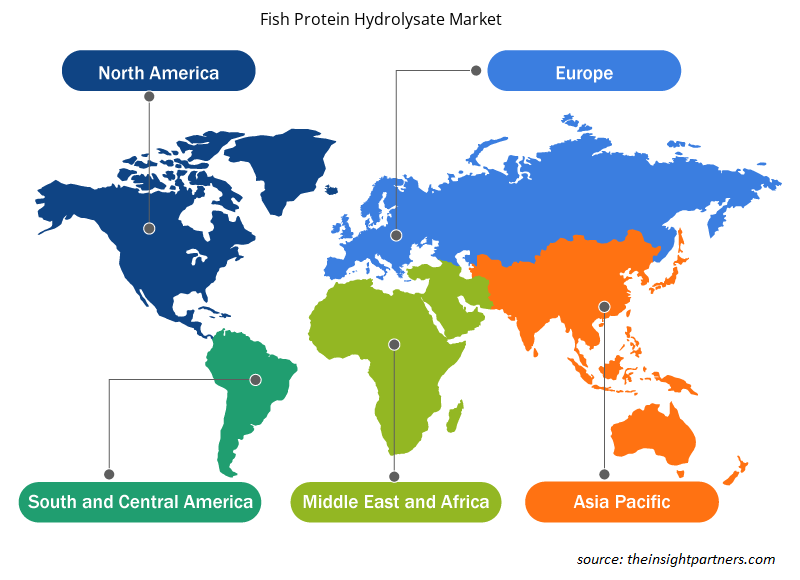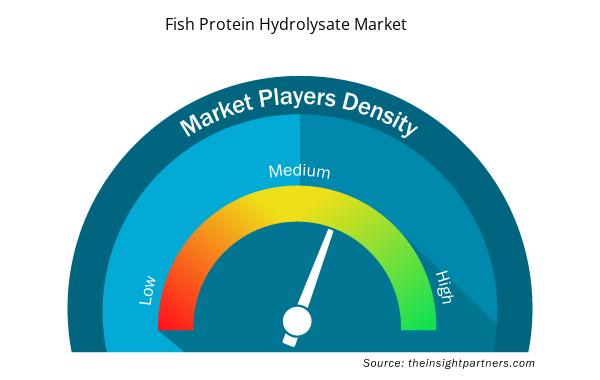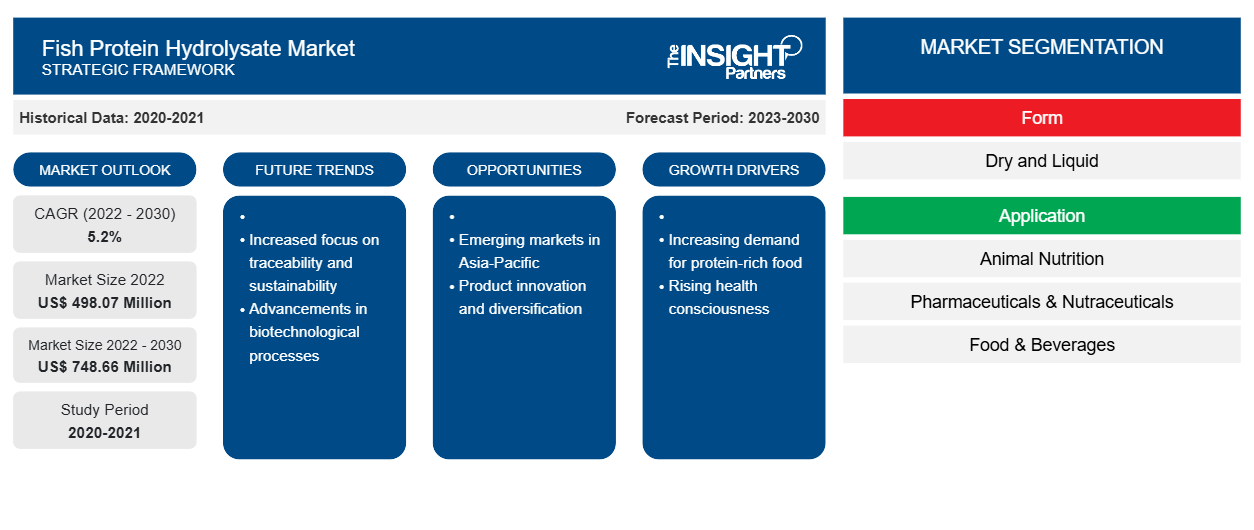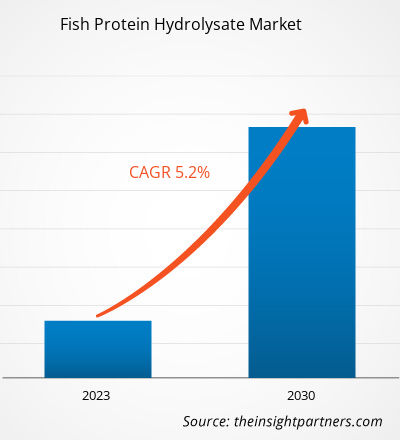[研究报告] 鱼蛋白水解物市场规模预计将从 2022 年的 4.9807 亿美元增长到 2030 年的 7.4866 亿美元;预计 2022 年至 2030 年的复合年增长率为 5.2%。
市场洞察和分析师观点:
鱼蛋白水解物是通过蛋白质水解的方法由鱼或鱼材料制成的产品。因此,鱼蛋白水解物是破碎蛋白质的混合物。据报道,与原始蛋白质相比,鱼蛋白水解物具有许多改进的特性,即改进的功能特性和生物活性特性,例如抗氧化或抗高血压活性。最近,鱼蛋白水解物也开始用作冷冻鱼产品的冷冻保护剂。这些因素预计将在预测期内推动鱼蛋白水解物市场的增长。
增长动力和挑战:
随着渔业技术的发展,渔业和水产养殖业的产量迅速增长。随着全球渔业产量的增加,产生了大量的鱼类废弃物。根据美国国家生物技术信息研究所 (NCBI) 的数据,大约三分之二的鱼类总产量被丢弃。通过添加各种蛋白水解酶,鱼类废弃物可以转化为 FPH 等增值产品。鱼类废弃物的皮、头、骨、内脏和肝脏是氨基酸、抗氧化剂、蛋白质和肽的良好来源。还发现这些废弃物具有理想的生物活性和功能性肽。因此,公司高度重视将鱼类废弃物用作食品和饮料、动物饲料和营养保健品等各个行业的蛋白质。因此,水产养殖和渔业增加的鱼类废弃物进一步推动了鱼蛋白水解物市场的增长。
此外,鱼蛋白水解物是蛋白质和磷、钙和其他矿物质等营养物质的良好来源。它有助于防止传染病的传播,并增强动物对真菌、细菌、病毒和寄生虫的免疫力。肉鸡经常食用鱼蛋白水解物有助于其肌肉发育。鱼蛋白水解物可以增强动物的代谢系统,从而保护它们免受疾病和感染的风险。因此,鱼蛋白水解物与动物健康有关的营养益处推动了其在动物饲料行业的需求。
然而,缺乏一个组织良好的收集、储存和运输模式会造成进一步的障碍,鱼类副产品可能会被浪费。此外,不可预见的障碍阻碍了新鲜食品供应链的顺畅流动,导致浪费并抑制市场需求。
定制此报告以满足您的需求
您可以免费定制任何报告,包括本报告的部分内容、国家级分析、Excel 数据包,以及为初创企业和大学提供优惠和折扣
- 获取此报告的关键市场趋势。这个免费样品将包括数据分析,从市场趋势到估计和预测。
报告细分和范围:
全球鱼蛋白水解物市场根据形态、应用和地域进行细分。根据形态,市场分为干鱼和液鱼。根据应用,市场细分为动物营养、食品和饮料、药品和营养保健品、个人护理和农业。此外,动物营养部分细分为家禽、反刍动物、猪、水产养殖、宠物和其他。根据地域,鱼蛋白水解物市场细分为北美(美国、加拿大和墨西哥)、欧洲(德国、法国、意大利、英国、俄罗斯和欧洲其他地区)、亚太地区(澳大利亚、中国、日本、印度、韩国和亚太其他地区)、中东和非洲(南非、沙特阿拉伯、阿联酋和中东和非洲其他地区)以及南美洲和中美洲(巴西、阿根廷和南美洲和中美洲其他地区)。
节段分析:
根据形态,鱼蛋白水解物市场分为干性和液体两类。干性部分在市场上占有较大的份额。由于粉末形式的鱼蛋白水解物保质期更长,运输和储存方便,因此对粉末形式的鱼蛋白水解物的需求高于液体形式。这些因素推动了粉末部分的市场增长。
区域分析:
从地理上看,鱼蛋白水解物市场分为五个主要区域——北美 (NA)、欧洲 (EU)、亚太地区 (APAC)、南美和中美以及中东和非洲。亚太地区主导着全球鱼蛋白水解物市场;2022 年该地区的市场价值为 1.7 亿美元。预计欧洲市场在预测期内的复合年增长率为 4.8%。亚太地区的发达国家和发展中国家的城市化进程不断加快,再加上中产阶级人口的增加,为市场参与者提供了许多机会。蛋白质补充剂需求增加以及个人和运动健身产品的使用增加等因素推动了亚太地区的需求。
北美占据鱼蛋白水解物市场的第二大份额,占近 30% 的市场份额。美国和加拿大消费者正在走向健康的生活方式,他们更喜欢提供健康益处的产品。消费者对健康的日益关注推动了北美鱼蛋白产品市场的增长。动物和植物食物来源的健康益处有助于提高能量水平、增强肌肉和骨骼结构、提高注意力和集中力以及各种其他健康益处,因此该地区倾向于水产营养。由于这个因素,北美对鱼蛋白水解物的需求正在上升。
行业发展和未来机遇:
鱼蛋白水解物市场的主要参与者采取的举措如下:
- 2021 年 5 月,领先的海洋原料生产生物科学公司 Biomega Group 宣布扩大其生物精炼业务,在丹麦希茨海尔斯投资新建绿地工厂。投资的目的是扩大公司的生产能力。
COVID-19 疫情影响:
COVID-19 疫情对各国几乎所有行业都产生了不利影响。北美、欧洲、亚太地区、南美和中美以及中东和非洲的封锁、旅行限制和企业关闭阻碍了食品和饮料、药品和营养品、个人护理、动物营养等多个行业的增长。制造部门的关闭扰乱了全球供应链、生产活动、交付计划以及必需品和非必需品销售。2020 年,各公司的产品交付延迟,产品销售下滑,这阻碍了鱼蛋白水解物市场的发展。在 COVID-19 疫情期间,劳动力短缺和原材料供应有限也导致全球运营和流程停止。这些因素对疫情期间的市场增长产生了负面影响。
为防止 COVID-19 蔓延,各国政府实施了各种贸易壁垒,阻碍了原材料的进口。中国、越南、印度、孟加拉国和埃及是主要原材料生产国,这导致世界其他地区对这些国家的依赖。在 COVID-19 疫情期间,许多国家实施的国际进出口禁令中断了原材料的供应。
然而,2021年,随着一些政府取消了先前实施的限制,各经济体恢复了运营,这对全球市场产生了积极影响。此外,制造商被允许满负荷生产,这有助于他们克服供需缺口。
鱼蛋白水解物市场区域洞察
Insight Partners 的分析师已详细解释了预测期内影响鱼蛋白水解物市场的区域趋势和因素。本节还讨论了北美、欧洲、亚太地区、中东和非洲以及南美和中美洲的鱼蛋白水解物市场细分和地理位置。

- 获取鱼蛋白水解物市场的区域特定数据
鱼蛋白水解物市场报告范围
| 报告属性 | 细节 |
|---|---|
| 2022 年市场规模 | 4.9807亿美元 |
| 2030 年市场规模 | 7.4866亿美元 |
| 全球复合年增长率(2022 - 2030 年) | 5.2% |
| 史料 | 2020-2021 |
| 预测期 | 2023-2030 |
| 涵盖的领域 | 按形式
|
| 覆盖地区和国家 | 北美
|
| 市场领导者和主要公司简介 |
|
鱼蛋白水解物市场参与者密度:了解其对业务动态的影响
鱼蛋白水解物市场正在快速增长,这得益于终端用户需求的不断增长,而这些需求又源于消费者偏好的不断变化、技术进步以及对产品优势的认识不断提高等因素。随着需求的增加,企业正在扩大其产品范围,进行创新以满足消费者的需求,并利用新兴趋势,从而进一步推动市场增长。
市场参与者密度是指在特定市场或行业内运营的企业或公司的分布情况。它表明在给定市场空间中,相对于其规模或总市场价值,有多少竞争对手(市场参与者)存在。
在鱼蛋白水解物市场运营的主要公司有:
- 德之馨
- 爱尔兰生物海洋原料
- 柯巴利斯
- 南太平洋岛屿国家
- 基明工业公司
免责声明:上面列出的公司没有按照任何特定顺序排列。

- 了解鱼蛋白水解物市场顶级关键参与者概况
竞争格局和重点公司:
Bio-marine Ingredients、Ireland Limited、Copalis Sea Solutions、CR Brown Enterprises、Diana Group、Hofseth BioCare ASA、Janatha Fish Meal & Oil Products、Marutham Bio Ages Innovations (P) Ltd、SAMPI、Scanbio Marine Group AS 和 Sopropêche 是全球鱼蛋白水解物市场的主要参与者。这些市场参与者采取战略发展举措来扩大业务,进一步推动鱼蛋白水解物市场的增长。
- 历史分析(2 年)、基准年、预测(7 年)及复合年增长率
- PEST 和 SWOT 分析
- 市场规模价值/数量 - 全球、区域、国家
- 行业和竞争格局
- Excel 数据集


- Employment Screening Services Market
- Emergency Department Information System (EDIS) Market
- Aquaculture Market
- Small Molecule Drug Discovery Market
- Grant Management Software Market
- Glycomics Market
- Collagen Peptides Market
- Hair Extensions Market
- Clear Aligners Market
- Personality Assessment Solution Market

Report Coverage
Revenue forecast, Company Analysis, Industry landscape, Growth factors, and Trends

Segment Covered
This text is related
to segments covered.

Regional Scope
North America, Europe, Asia Pacific, Middle East & Africa, South & Central America

Country Scope
This text is related
to country scope.
常见问题
The fishery industry is growing due to improved aquaculture production, changing cultural preferences, and surging demand for fish and seafood. The increasing number of fisheries generates a large volume of waste almost every year, estimated at nearly 60% of the biomass. The waste is processed and used to manufacture fish protein hydrolysate. In aquaculture, FPH demand is gaining massive momentum as it enhances the metabolic system of species that protect them from the risk of diseases and infections. Hence, aquafeed producers are increasingly adopting effective feeding practices and incorporating health-promoting compounds such as proteins, hydrolysates, and bioactive peptides, including fish protein hydrolysate. Due to these factors, the growing aquaculture industry is expected to create lucrative opportunities for the FPH market in the coming years.
The World Organization for Animal Health states that more than 50 wildlife diseases can seriously impact livestock and public health. In this case, implementation of appropriate nutritional strategies that boost immunity, develop animal health, promote intestinal integrity and functionality is critical to enhance animal stress tolerance and treat various diseases. Thus, fish protein hydrolysates for animal feed applications are used to fulfill the nutritional demands of livestock. FPH is a good source of protein and nutrients such as phosphorus, calcium, and other minerals. It helps prevent the spread of infectious diseases and boosts animal immunity against fungi, bacteria, viruses, and parasites. Regular consumption of FPH by broiler chickens helps in their muscle development. Enzymes present in fish protein hydrolysate aid in the gut morphology of broilers by facilitating the digestion of fibrous food, including grains and soybean meal.
Based on the application, animal nutrition segment is hold a significant share in the market. Fish protein hydrolysate is used largely in animal nutrition owing to various benefits offered. It helps to prevent allergic reactions and ensures desirable growth performance rate of animals and feed efficiency. Hence, it has demand in the poultry industry. These benefits associated with incorporating fish protein hydrolysate in poultry feed surged its market growth.
The major players operating in the global fish protein hydrolysate market are Symrise; Bio-marine Ingredients Ireland; Copalis; SAMPI; Kemin Industries, Inc; Janatha Fish Meal & Oil Products; E.F.S.-Holland; WHITE SWAN PHARMACEUTICA; New Alliance Dye Chem Pvt. Ltd; and Nizona Marine Products.
Based on form, dry segment mainly has the largest revenue share. The growth of the segment has surged due to its excellent physiochemical stability, extended shelf-life, and ease of transportation features. The bioavailability of fish protein hydrolysate in dry form is rapid and less prone to microbial attack. Such benefits of fish protein hydrolysate have surged its use in various industries like animal nutrition, food and beverages, and others.
Asia Pacific accounted for the largest share of the global fish protein hydrolysate market. Asian countries were the primary producers, accounting for 70% of the total fisheries and aquaculture production of aquatic animals. China, Indonesia, India, Vietnam, and the Philippines are the top Asian countries that lead the production capacity of aquaculture in the world and comprise more than half of the total production. More than 90% of the global aquaculture harvest is in Asia. The proliferating aquaculture production increases the intake of aquafeed across the region. Hence, aquafeed producers are increasingly seeking nutritional ingredients to formulize protein-rich feed.
Trends and growth analysis reports related to Food and Beverages : READ MORE..
The List of Companies - Fish Protein Hydrolysate Market
- Symrise
- Bio-marine Ingredients Ireland
- Copalis
- SAMPI
- Kemin Industries, Inc
- Janatha Fish Meal and Oil Products
- E.F.S.-Holland
- WHITE SWAN PHARMACEUTICA
- New Alliance Dye Chem Pvt. Ltd
- Nizona Marine Products
The Insight Partners performs research in 4 major stages: Data Collection & Secondary Research, Primary Research, Data Analysis and Data Triangulation & Final Review.
- Data Collection and Secondary Research:
As a market research and consulting firm operating from a decade, we have published and advised several client across the globe. First step for any study will start with an assessment of currently available data and insights from existing reports. Further, historical and current market information is collected from Investor Presentations, Annual Reports, SEC Filings, etc., and other information related to company’s performance and market positioning are gathered from Paid Databases (Factiva, Hoovers, and Reuters) and various other publications available in public domain.
Several associations trade associates, technical forums, institutes, societies and organization are accessed to gain technical as well as market related insights through their publications such as research papers, blogs and press releases related to the studies are referred to get cues about the market. Further, white papers, journals, magazines, and other news articles published in last 3 years are scrutinized and analyzed to understand the current market trends.
- Primary Research:
The primarily interview analysis comprise of data obtained from industry participants interview and answers to survey questions gathered by in-house primary team.
For primary research, interviews are conducted with industry experts/CEOs/Marketing Managers/VPs/Subject Matter Experts from both demand and supply side to get a 360-degree view of the market. The primary team conducts several interviews based on the complexity of the markets to understand the various market trends and dynamics which makes research more credible and precise.
A typical research interview fulfils the following functions:
- Provides first-hand information on the market size, market trends, growth trends, competitive landscape, and outlook
- Validates and strengthens in-house secondary research findings
- Develops the analysis team’s expertise and market understanding
Primary research involves email interactions and telephone interviews for each market, category, segment, and sub-segment across geographies. The participants who typically take part in such a process include, but are not limited to:
- Industry participants: VPs, business development managers, market intelligence managers and national sales managers
- Outside experts: Valuation experts, research analysts and key opinion leaders specializing in the electronics and semiconductor industry.
Below is the breakup of our primary respondents by company, designation, and region:

Once we receive the confirmation from primary research sources or primary respondents, we finalize the base year market estimation and forecast the data as per the macroeconomic and microeconomic factors assessed during data collection.
- Data Analysis:
Once data is validated through both secondary as well as primary respondents, we finalize the market estimations by hypothesis formulation and factor analysis at regional and country level.
- Macro-Economic Factor Analysis:
We analyse macroeconomic indicators such the gross domestic product (GDP), increase in the demand for goods and services across industries, technological advancement, regional economic growth, governmental policies, the influence of COVID-19, PEST analysis, and other aspects. This analysis aids in setting benchmarks for various nations/regions and approximating market splits. Additionally, the general trend of the aforementioned components aid in determining the market's development possibilities.
- Country Level Data:
Various factors that are especially aligned to the country are taken into account to determine the market size for a certain area and country, including the presence of vendors, such as headquarters and offices, the country's GDP, demand patterns, and industry growth. To comprehend the market dynamics for the nation, a number of growth variables, inhibitors, application areas, and current market trends are researched. The aforementioned elements aid in determining the country's overall market's growth potential.
- Company Profile:
The “Table of Contents” is formulated by listing and analyzing more than 25 - 30 companies operating in the market ecosystem across geographies. However, we profile only 10 companies as a standard practice in our syndicate reports. These 10 companies comprise leading, emerging, and regional players. Nonetheless, our analysis is not restricted to the 10 listed companies, we also analyze other companies present in the market to develop a holistic view and understand the prevailing trends. The “Company Profiles” section in the report covers key facts, business description, products & services, financial information, SWOT analysis, and key developments. The financial information presented is extracted from the annual reports and official documents of the publicly listed companies. Upon collecting the information for the sections of respective companies, we verify them via various primary sources and then compile the data in respective company profiles. The company level information helps us in deriving the base number as well as in forecasting the market size.
- Developing Base Number:
Aggregation of sales statistics (2020-2022) and macro-economic factor, and other secondary and primary research insights are utilized to arrive at base number and related market shares for 2022. The data gaps are identified in this step and relevant market data is analyzed, collected from paid primary interviews or databases. On finalizing the base year market size, forecasts are developed on the basis of macro-economic, industry and market growth factors and company level analysis.
- Data Triangulation and Final Review:
The market findings and base year market size calculations are validated from supply as well as demand side. Demand side validations are based on macro-economic factor analysis and benchmarks for respective regions and countries. In case of supply side validations, revenues of major companies are estimated (in case not available) based on industry benchmark, approximate number of employees, product portfolio, and primary interviews revenues are gathered. Further revenue from target product/service segment is assessed to avoid overshooting of market statistics. In case of heavy deviations between supply and demand side values, all thes steps are repeated to achieve synchronization.
We follow an iterative model, wherein we share our research findings with Subject Matter Experts (SME’s) and Key Opinion Leaders (KOLs) until consensus view of the market is not formulated – this model negates any drastic deviation in the opinions of experts. Only validated and universally acceptable research findings are quoted in our reports.
We have important check points that we use to validate our research findings – which we call – data triangulation, where we validate the information, we generate from secondary sources with primary interviews and then we re-validate with our internal data bases and Subject matter experts. This comprehensive model enables us to deliver high quality, reliable data in shortest possible time.


 获取此报告的免费样本
获取此报告的免费样本